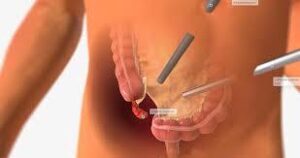Appendicectomy

Appendicectomy
Appendicectomy, commonly known as appendix removal, is a surgical procedure aimed at extracting the appendix from the abdomen. This can be accomplished through either an open surgical approach (traditional method) or a laparoscopic procedure (keyhole surgery).
- The appendix is a small, finger-shaped pouch attached to the cecum, the first part of the large intestine, typically located in the lower right quadrant of the abdomen.
- Appendicitis, often the reason for appendicectomy, occurs when a blockage in the appendix leads to infection, causing inflammation, swelling, and pus accumulation. Untreated, appendicitis can result in a ruptured appendix, leading to peritonitis, a potentially life-threatening condition.
Symptoms:
- Sudden pain in the lower abdomen, typically on the right side
- Pain starting near the navel and shifting to the lower right abdomen
- Pain aggravated by coughing, walking, or other movements
- Nausea, loss of appetite, low-grade fever
- Constipation or diarrhea, abdominal bloating
Diagnosis:
- Urine and blood tests to detect infection
- Abdominal x-ray and CT scan to visualize the appendix and surrounding structures
Procedure:
Open Appendectomy:
- Involves an incision in the lower right abdomen, followed by removal of the appendix. The incision is then closed with dissolvable stitches.
- May include insertion of a drainage tube to remove fluids.
Laparoscopic Appendectomy:
- A minimally invasive approach utilizing small incisions, a laparoscope (camera), and surgical instruments.
- Surgeon visualizes the abdomen on a monitor and removes the appendix using specialized tools.
- Incisions are closed with stitches or adhesive tapes, covered with sterile dressings.
Antibiotics are administered before, during, and after surgery to prevent infection, especially in cases of a ruptured appendix.
Post-Procedure:
- Follow dietary recommendations provided by the doctor.
- Use mild laxatives if necessary in the initial days.
- Stay hydrated with plenty of water to prevent constipation.
- Ensure adequate rest and avoid heavy lifting or strenuous activities.
- Gradually resume normal activities and incorporate gentle exercise.
Risks:
- Bleeding
- Infection
- Damage to surrounding abdominal structures
For further guidance on post-procedural care or to address any concerns, consult your healthcare provider.

